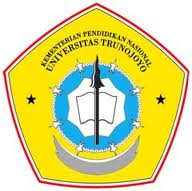Anda belum Log-in!
Silahkan Log in
Selamat Datang di Portal Digital Content Publisher
Selasa , 20 May 2025
Perpustakaan sebagai jantung pendidikan tinggi di Indonesia, harus mampu memberi kontribusi yang berarti bagi pelaksanaan proses belajar mengajar di perguruan tinggi.
di-posting oleh 140331100051 pada 2019-02-02 13:00:46 • 330 klik
FRUIT-BASED EDIBLE FILM ADDITIVE-FREE MENGGUNAKAN SIWALAN (Borassus Flabellifer L.)
FRUIT-BASED EDIBLE FILM ADDITIVE-FREE USING SIWALAN (Borassus Flabellifer L.)
disusun oleh SAMSUL ARIFIN
| Subyek: | Edible film Siwalan dan pati singkong |
| Kata Kunci: | Edible film Siwalan Pati RSM |
[ Anotasi Abstrak ]
Limbah yang dihasilkan oleh indonesia mencapai 187,2 juta ton pertahun sebanyak 20,6 juta ton pertahun yang dihasilkan berupa limbah plastik yang umumnya terbuat dari polimer dari sumber minyak bumi. Biopolimer telah dipelajari sebagai bahan pembentuk film untuk digunakan sebagai biodegradable dan edible film sebagai kemasan makanan dalam mengurangi limbah plastik. Tujuan dari penelitian ini untuk mengetahui sifat fisik dan kimia serta pengaruh proporsi siwalan dan pati singkong dalam pembuatan edible film. Dengan metode RSM dan rancangan CCD menggunakan aplikasi minitab dalam menemukan titik optimum. Dengan hasil yang didapat berupa proporsi siwalan berpengaruh positif pada nilai Moisture absorption dan berpengaruh negatif pada nilai Water Vapor Permeability. Proporsi pati berpengaruh positif pada nilai ketebalan, kuat Tarik, modulus young, Moisture absorption dan berpengaruh negatif pada nilai nilai a, elongasi, WVP serta kadar air. Titik optimum siwalan sebesar 16,18 g dan pati singkong sebesar 5,19 g dapat diprediksi memperoleh nilai kadar air minimum sebesar 11,37%, nilai ketebalan minimum sebesar 0,065 cm, kuat tarik maksimum sebesar 0,3684 Mpa, kemuluran maksimum 4,11%, Modulus young maksimum sebesar 0,0907 dengan nilai a maksimum + 3,88 (merah), moisture absorption minimum sebesar 6,59% dan WVP minimum -0,0391 g/m2.day.
Deskripsi Lain
The waste produced by Indonesia reaches 187.2 million tons per year as much as 20.6 million tons per year which is produced in the form of plastic waste which is generally made from polymers from petroleum sources. Biopolymers have been studied as film-forming materials to be used as biodegradable and edible films as food packaging in reducing plastic waste. The purpose of this study was to determine the physical and chemical properties and the influence of the proportion of siwalan and cassava starch in the manufacture of edible films. With the RSM method and the design of the CCD using the Minitab application in finding the optimum point. With the results obtained in the form of siwalan proportions have a positive effect on the value of moisture absorption and have a negative effect on the value of Water Vapor Permeability. The proportion of starch has a positive effect on the value of thickness, tensile strength, modulus young, moisture absorption and a negative effect on the values of a, elongation, WVP and water content. The optimum siwalan point of 16.18 g and cassava starch of 5.19 g can be predicted to obtain a minimum water content value of 11.37%, minimum thickness value of 0.065 cm, maximum tensile strength of 0.3684 Mpa, maximum elongation of 4.11 %, Maximum young modulus of 0.0907 with a maximum value of + 3.88 (red), minimum moisture absorption of 6.59% and minimum WVP of -0.0391 g / m2.day.
| Kontributor | : Ir. Umi Purwandari, M.App.Sc. Ph.D;Millatul Ulya, S.TP., MT |
| Tanggal tercipta | : 2019-01-21 |
| Jenis(Tipe) | : Text |
| Bentuk(Format) | |
| Bahasa | : Indonesia |
| Pengenal(Identifier) | : TRUNOJOYO-Tugas Akhir-15236 |
| No Koleksi | : 140331100051 |
Sumber :
Universitas Trunojoyo Madura
Ketentuan (Rights) :
21 Januari 2019
 Download File Penyerta (khusus anggota terdaftar)
Download File Penyerta (khusus anggota terdaftar) 1. TRUNOJOYO-Tugas Akhir-15236-140331100051_Cover.pdf - 486 KB
1. TRUNOJOYO-Tugas Akhir-15236-140331100051_Cover.pdf - 486 KB 2. TRUNOJOYO-Tugas Akhir-15236-140331100051_Abstract.pdf - 168 KB
2. TRUNOJOYO-Tugas Akhir-15236-140331100051_Abstract.pdf - 168 KB 3. TRUNOJOYO-Tugas Akhir-15236-140331100051_Chapter1.pdf - 96 KB
3. TRUNOJOYO-Tugas Akhir-15236-140331100051_Chapter1.pdf - 96 KB 4. TRUNOJOYO-Tugas Akhir-15236-140331100051_Chapter2.pdf - 179 KB
4. TRUNOJOYO-Tugas Akhir-15236-140331100051_Chapter2.pdf - 179 KB 5. TRUNOJOYO-Tugas Akhir-15236-140331100051_Chapter3.pdf - 342 KB
5. TRUNOJOYO-Tugas Akhir-15236-140331100051_Chapter3.pdf - 342 KB 6. TRUNOJOYO-Tugas Akhir-15236-140331100051_Chapter4.pdf - 617 KB
6. TRUNOJOYO-Tugas Akhir-15236-140331100051_Chapter4.pdf - 617 KB 7. TRUNOJOYO-Tugas Akhir-15236-140331100051_Conclusion.pdf - 91 KB
7. TRUNOJOYO-Tugas Akhir-15236-140331100051_Conclusion.pdf - 91 KB 8. TRUNOJOYO-Tugas Akhir-15236-140331100051_References.pdf - 238 KB
8. TRUNOJOYO-Tugas Akhir-15236-140331100051_References.pdf - 238 KB 9. TRUNOJOYO-Tugas Akhir-15236-140331100051_Appendices.pdf - 698 KB
9. TRUNOJOYO-Tugas Akhir-15236-140331100051_Appendices.pdf - 698 KB Dokumen sejenis...
Dokumen sejenis...Tidak ada !
 Dokumen yang bertautan...
Dokumen yang bertautan...- ANALISIS SENSORIS PADA MANISAN KERING RAMBUTAN DENGAN VARIASI KONSENTRASI LARUTAN KAPUR, SUHU DAN WAKTU PENGERINGAN
- OPTIMASI JUMLAH PRODUK DALAM PENYUSUNAN RENCANA PRODUKSI HARIAN ROTI DENGAN MENGGUNAKAN DYNAMIC PROGRAMMING DI LYLY BAKERY LAMONGAN
- PENJADWALAN MATA KULIAH MENGGUNAKAN METODE ALGORITMA GENETIKA
- PENGARUH PENGGUNAAN DAUN JAMBU BIJI DAN LARUTAN KAPUR TERHADAP KUALITAS NIRA SIWALAN
- PENGARUH PENGGUNAAN CABAI RAWIT(Capsicum frutescens linn) DAN LARUTAN KAPUR TERHADAP KUALITAS NIRA SIWALAN
 Kembali ke Daftar
Kembali ke Daftar 